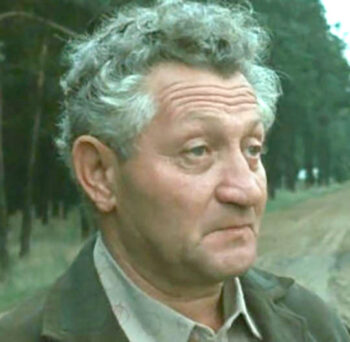Srebrnik, Szymon

Szymon Srebrnik (10 April 1930 – 16 Aug. 2006) was a Polish Jew who, during an interview with Judge Bednarz on 29 June 1945, claimed that at age 13 he was arrested with his mother and taken to the Chełmno Camp. He is one of only three Chełmno inmates who have testified about their alleged experiences. The other two are Michał Podchlebnik and Mieczysław Żurawski.
A year later, Srebrnik made a deposition for the Central Commission for Jewish History. Fifteen years later, he testified during the Eichmann show trial in Jerusalem, a few years after that at the German Chełmno show trial at Bonn, and finally he was interviewed by Claude Lanzmann for his 1985 documentary Shoah. Here are the main peculiarities of his various testimonies:
- In 1945, he claimed to have arrived at Chełmno in March 1944, but during the Eichmann Trial, he claimed that he arrived there in the summer of 1943, or maybe closer to 1944. Either way, the orthodoxy insists that the Chełmno Camp was inactive between April 1943 and April 1944, so neither of Srebrnik’s dating is possible.
- Had Chełmno really been an extermination camp where everyone was killed more-or-less on arrival, with only a few strong, healthy and young men kept as slaves to fell trees, chop them up, dig mass graves, haul corpses, arrange pyres, crush cremation remains, then no boy of age 13 would have survived. Yet Srebrnik claims to have done all these jobs for about a year at age 13/14.
- Srebrnik even claimed that, as a 13/14-year-old boy, he won long jumping and racing contests against other – grown-up – inmates.
- He made frequent row-boat trips together with SS men, singing Polish folk tunes and Prussian military songs together.
- The first job he allegedly had to do was removing the rubble of a destroyed house. In the debris, they found “skulls, hands and legs,” allegedly the remnants of Jews who had been locked up inside the house, and were then killed by blowing up the premise. This would have been a ludicrously inefficient way of killing people.
- With each interrogation, he claimed a higher death toll for the camp: in his 1945 interview, he claimed that a total of 15,000 Jews had been killed in 1944 at Chełmno. During the 1961 Eichmann Trial, this grew to 1,000 to 1,200 victims daily for 9 months straight, or more than 300,000 just for 1944. During the interview with Claude Lanzmann, the daily death toll had grown to 2,000, which results in 540,000 victims for 9 months. The orthodoxy insists, however, that less than 10,000 victims were killed there in 1944.
- When Judge Bednarz showed a photo of a derelict Magirus truck on the grounds of the Ostrowski Company, Srebrnik enthusiastically recognized and identified this vehicle as one of the gas vans allegedly used at Chełmno. Yet that truck was an ordinary moving truck, as Bednarz’s report on that truck shows.
- Srebrnik claimed that some Jews, when tending the pyres, suddenly caught fire and died in the flames themselves, which he called “instances of unintended self-incineration.” While one would suffer serious burns when working without protective clothes near large-scale fires, no person ever would catch fire and burn to ashes.
- In his 1945 deposition, he told a tale how a co-inmate had to throw his gassed sister into the fire, where she suddenly came back to life and cursed him shouting, “You murderer, why are you throwing me into the furnace? I’m still alive.” No one can breathe while inside a blaze, let alone shout at anyone. So, during the Eichmann Trial, he dropped the claim that his coinmate’s sister came back to life…
- During his interview with Lanzmann, Srebrnik topped the story of the flame-resuscitated sister by claiming that an entire load of Jews presumably gassed in a gas van came back to life, but they were thrown into the fire by Srebrnik and his colleagues anyhow, alive, without offering resistance. “They could feel the fire burn them.”
- When the camp was dissolved, he claimed that he was executed with a shot into the neck, but the bullet exited through his mouth and tip of the nose without killing him. If that were so, it would have caused serious damage to the front of his upper jaw, destroying his incisors in the process. Yet all photos of him show no serious scarring above his upper lip or lower nose, and he also had all his teeth. (During the Eichmann trial, a little scar he had on his nose was no longer caused by a bullet but by some glass sliver.)
- Wounded as he allegedly was, he heroically broke both headlights of the SS’s car illuminating the scene. No one noticed the noise this lengthy and violent process would have caused, and no one noticed the sudden darkness either, so he managed to run away into the darkness. In later statements, he no longer claimed that, though…
He explained to Lanzmann how he coped:
“When I saw all that, it didn’t affect me. […] I was only 13 years old and all I’d ever seen until I came here were dead bodies. Maybe I didn’t understand.”
It is more likely, however, that he wasn’t affected by all he claims to have experienced because it was all a figment of the imagination.
(For more details, see Alvarez 2011; 2023, pp. 158-160, 171-173; Mattogno 2017, pp. 63-67).

You need to be a registered user, logged into your account, and your comment must comply with our Acceptable Use Policy, for your comment to get published. (Click here to log in or register.)